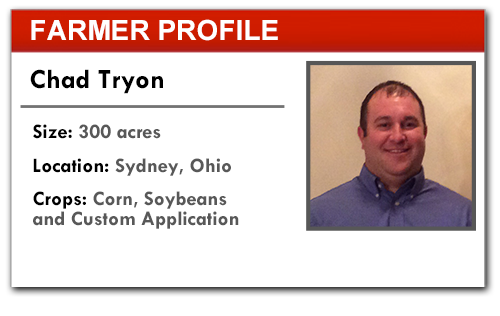 It’s one thing to have issues with your own precision farming equipment, but when you’re a custom applicator serving a 60-mile radius of farmers who operate more than 20,000 acres, precision equipment uptime takes on a new meaning.
It’s one thing to have issues with your own precision farming equipment, but when you’re a custom applicator serving a 60-mile radius of farmers who operate more than 20,000 acres, precision equipment uptime takes on a new meaning.
Chad Tryon, who primarily works with Crop Production Services (CPS) in Sydney, Ohio, also uses precision equipment on the 300 acres he operates on the side. Between the two enterprises, he gets to “interface” with a variety of programs and then figure out a way to transfer that farm information across platforms.
He has worked with CPS for 7 years and been investing and adopting precision cropping systems for 9 years. “We have been ramping up the last 4 years to improve our soil sampling equipment and information,” he says.
They rely on Agrium’s Echelon software for soil testing and data analysis, which he finds intuitive to use. “We can pull up data by farmer, then by the field,” Tryon says. “We can see where samples have been pulled and we can overlay fertilizer application information and yield data. It also figures variable-rate information for fertilizer.”
For fertilizer application, Tryon runs either a 4904 or 4930 John Deere spreader outfitted with a New Leader L3030G4 MultApplier-Ready bed with twin bins. “These are controlled by a John Deere GS2630 monitor that follows a WAAS signal. We will also variable-rate apply anhydrous with N-Serve using the 2630 as a controller through a Case IH 3900 toolbar.”
On his own operation, Tryon uses a Trimble 500 controller for guidance while planting and spraying. He also uses it to gather yield data.
What Farmers Want From You is a series of farmer profiles that examine the scope of precision farming tools individual farmers are using on their operation, along with the frustrations that can occur with adopting new technology and how dealers can alleviate those "points of pain" for farm customers. For the latest additions to the series, visit our What Farmers Want From You feed.
“It’s a simple system that gathers the information I need and gives me the level of guidance I am looking for,” he says. “I know how to make it work and I am confident that it will work. But if it quits and you give up on it, you’re done. That information doesn’t get collected.”
Points of Pain: Data Exchange and Farmer Training
Tryon likes the ease of the Echelon system, until it comes to transferring data to the GS 2630 monitors for application or to farmers so they can import it onto their monitors.
“We give the farmers the information on a card and it doesn’t always upload correctly,” he says. “Sometimes, we run the data through Deere’s AgLogic software to get it to upload to the 2630.
“We find many times that the problem is because farmers don’t update their systems, and then it won’t accept data correctly.”
Tryon also finds that some farmers, due to inadequate training, get frustrated with the equipment and turn it off when they’re busy during spring or fall, losing variable-rate capability and as-planted data or yield information.
“If the dealers would take more time and offer more training opportunities closer to peak seasons, farmers might be less likely to shut off these systems they’ve already paid for,” he says.
Tryon says he generally has good luck using the 2630 monitors for variable-rate fertilizer application, but when farmers have a combine or tractor with the technology and don’t know how it works or how to use it, dealer’s can serve those customers by helping them learn how to use the equipment.



![[Technology Corner] Discussing AI’s Potential Impact on Service & Support](https://www.precisionfarmingdealer.com/ext/resources/2025/04/11/Discussing-AIs-Potential-Impact-on-Service--Support.png?height=290&t=1744385717&width=400)


